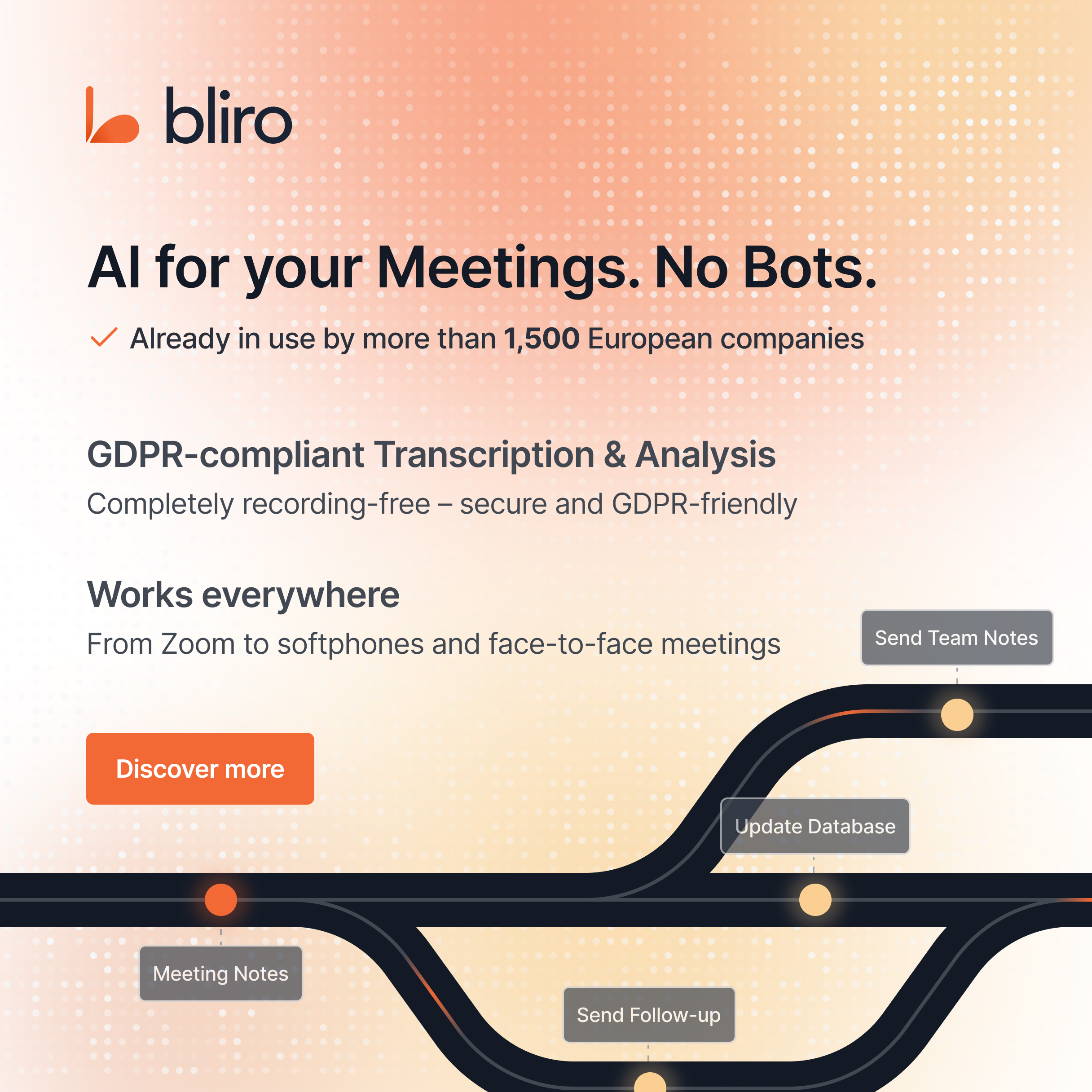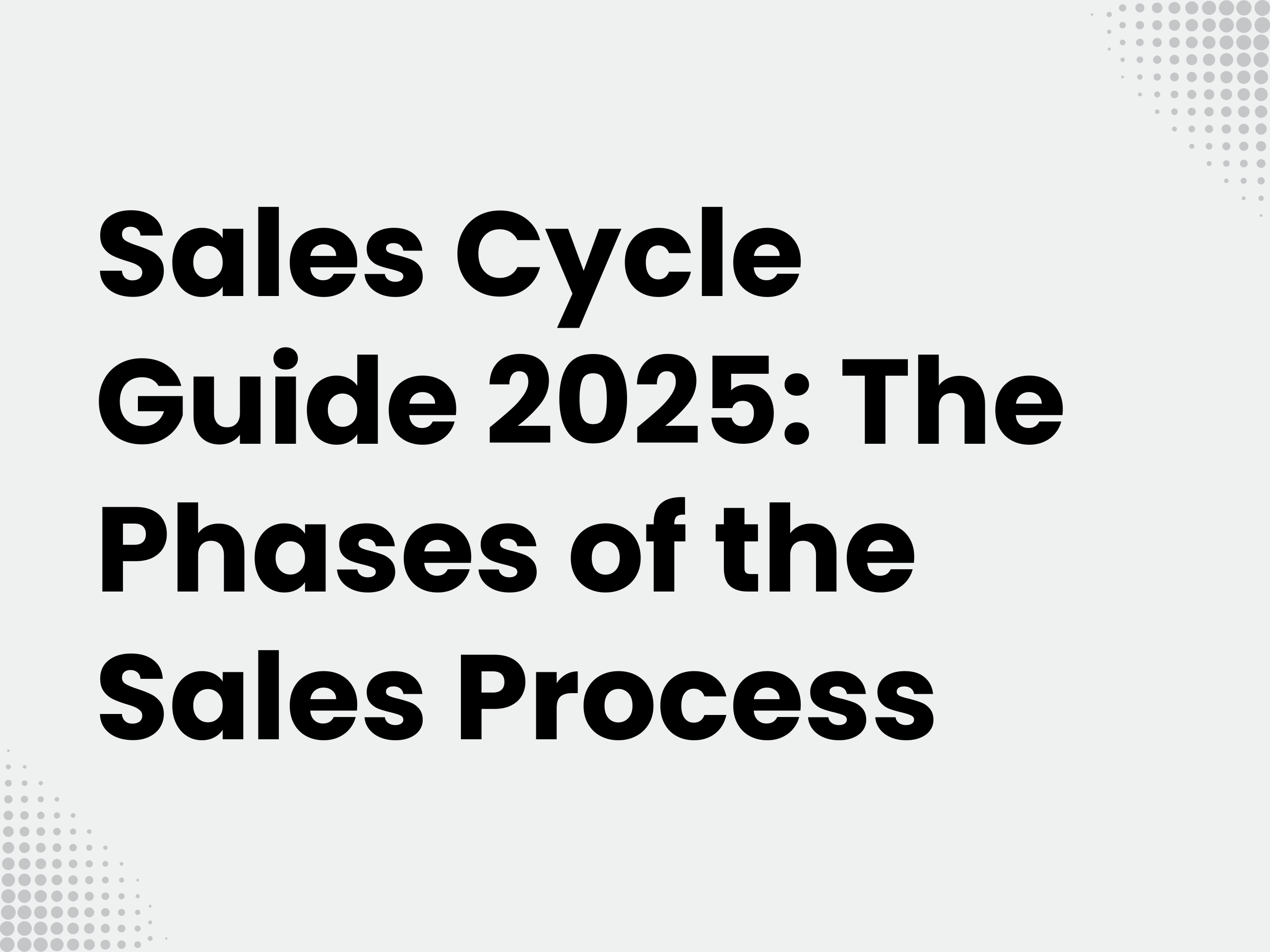The Sales Cycle forms the basis of successful sales work. Seven structured phases systematically guide potential customers from the first meeting to the conclusion of a purchase.
Technical literature defines these seven decisive factors phases as a standard framework for sales teams. Structured sales processes help you increase closing rates and identify bottlenecks in good time. In the B2B sector, the process is becoming more complex: investment decisions go through several departments and management levels.
Your sales cycle functions as an orientation, not as a rigid set of rules. Industry, product complexity and company size determine individual requirements. Tools like Bliro help you automatically document customer data at every stage and transfer it seamlessly to CRM.
Discover the seven sales cycle phases, their B2B features and tried and tested optimization strategies for 2025.
What is a sales cycle?
The sales cycle defines the structured sales process from the initial customer approach to the final conclusion of the contract. This systematic approach is at the heart of professional sales work.
Definition and meaning in sales
A sales cycle comprises all phases and activities that transform prospects into paying customers. The process starts with lead generation and ends with successful completion.
Sales teams use this structure to systematically process sales opportunities and identify bottlenecks at an early stage. As a result, companies can process durations and measure and identify optimization potential.
Cycle time varies significantly depending on industry and product complexity. B2B software typically requires 4-6 months, while complex B2B solutions require 6-9 months. SaaS companies have cycles of between 2-12 months, large companies can 6-18 months require.
Difference between sales funnel and sales cycle
Sales cycle and sales funnel fulfill different functions in sales:
The sales cycle follows the individual path of a specific prospective customer through the buying process. The sales funnel, on the other hand, visualizes the entirety of all active sales processes and shows how many leads are in each phase.
The funnel serves as a management tool for an overview of all ongoing deals. The cycle focuses on the detailed development of individual sales opportunities. This distinction enables precise sales management and realistic forecasts.
Why a structured sales process is crucial
Structured sales cycles bring measurable benefits:
- Increased efficiency: Clear processes speed up sales processes. 90% of companies with a formalized sales process are among the most powerful companies.
- Precise measurability: Defined phases make sales work quantifiable and assessable.
- Higher completion rates: Standardised processes increase sales by up to 28% versus unstructured approaches.
- Customer orientation: Systematic processes create positive customer experiences instead of random sales attempts.
- Quick scaling: New employees learn established processes more efficiently.
Modern tools such as Bliro automate conversation documentation and CRM integration. This allows you to keep track of deal status and address customer needs in a more targeted manner.

The 7 phases of the sales cycle at a glance
Successful sales processes follow a clear structure. These seven phases form your framework for systematic customer acquisition - adapted to the industry, product and business model.
1. Lead generation: Identify potential customers
Identify people or companies with a fundamental interest in your offer. Online channels such as content marketing, SEO, social media and newsletters generate qualified contacts. Trade fairs, events or cold calls work offline.
Know your target group precisely and address them with relevant content. Blog posts, white papers, webinars, or e-books that solve specific problems of your target customers draw Marketing Qualified Leads (MQLs) on. They have already signaled interest by leaving contact details in exchange for valuable content.
2. Contact: Make the first wire
Contact potential prospects as soon as possible. Studies show that contact within an hour is optimal. Find out where the prospect is in their customer journey and what information they need.
E-mail, telephone or social media enable initial discussions to assess needs. Bliro automatically documents these initial meetings and immediately transfers important findings to the CRM system - no detail is lost.
3. Qualification: Does the lead fit the target group?
Prevent wasted time on inappropriate contacts through systematic lead qualification. The BANT method checks four decisive criteria:
- Budget: Does the lead have sufficient financial resources?
- Authority: Are you talking to the decision maker?
- Need: Is there an actual need for your product?
- Timing (time frame): When should the purchase decision be made?
Lead scoring systems rate contacts according to purchase probability. Give points for activities such as webinar participation or white paper downloads.
4. Nurturing: building trust and generating demand
Leads that are not ready to buy require continuous support. Build trust and keep contact warm. B2B buying processes take time several months or even years.
Drip campaigns via email, regular updates with valuable content, webinars, or social media interactions keep you in the memory of your leads. Remain top-of-mind as a trustworthy point of contact.
5. The offer: Present an individual solution
Advanced prospects develop a purchase request. Create specific offers for leads who request demos or trials, or need pricing information.
Tailor offers individually to needs and wishes. The more precisely the specific requirements are addressed, the higher the probability of a positive response.
6. Handling objections: Overcoming hurdles in conversation
Objections show active engagement with your offer. Typical concerns include price, time frame, or technical details.
Use proven techniques such as the Boomerang method: Take up the objection and use it as an argument for your product. Targeted counterquestions identify the real concerns. Document recurring objections for proactive treatment
7. Conclusion: From prospect to customer
After clarifying all objections, actively ask about the purchase decision. Prepare all necessary documents to enable immediate signing.
After successful completion, start aftercare. Provide questions and ensure smooth onboarding. This creates customer loyalty and opens up cross-selling or upselling opportunities.
Sales cycle in B2B: special features and challenges
B2B sales processes present sales teams with different challenges than B2C transactions. More complex decision-making structures and longer cycles require adapted strategies.
Longer decision-making processes and buying centers
B2B buying decisions take an average of 6-18 months. Complex solutions can take several years. The reason: Individuals rarely make decisions alone.
The Buying Center determines the process - a body of different stakeholders with different interests. Up to seven people are typically involved:
- Initiators: identify needs and start the process
- Gatekeepers: manage the flow of information to decision makers
- Influencers: provide technical recommendations
- Decision-makers: make final purchase decisions
- Users: actually working with a product or service
Bliro automatically documents all stakeholder conversations and makes it easier to manage complex buying center relationships.
Complex products and individual requirements
B2B products require intensive explanations. 43% of sellers are unable to effectively present complex solutions online. Challenges include:
- Product portfolios with tens of thousands of variants
- Customer-specific adjustments
- Integration into existing systems
- In-depth technical specifications
A single contact is rarely enough to complete. Sales teams must address all stakeholders in a targeted manner and understand their specific needs.
Exemplary B2B sales cycle process
B2B processes differ in the intensity and depth of the phases:
- Acquisition of qualified leads: targeted market research instead of mass generation
- Contact: Immediate added value for potential customers
- Lead qualification: Intensive review of supply-demand agreement
- Nurturing: Critical for lengthy decision-making processes involving multiple participants
- Preparation of offers: Tailored to specific technical requirements
- Handling objections: Multiple rounds of talks with various stakeholders
- Conclusion and aftercare: contract negotiation and continuous support
Automated tools such as Bliro document every step efficiently - valuable insights are not lost.
Optimize sales cycle: strategies for greater efficiency
Efficiency determines the success of your sales process. Continuous optimization uses resources in a targeted manner and measurably increases sales.
Lead qualification using the BANT method
The BANT method qualifies leads systematically based on four decisive criteria:
- Budget: Does the lead have sufficient financial resources?
- Authority: Are you talking to the person responsible for making decisions?
- Need: Do lead requirements and product features match?
- Timing: When does the lead need the product?
This structured approach prevents wasted resources for inappropriate contacts.
Review sales strategy regularly
80% of companies must partially or completely revise their sales strategy. Only 20% of decision makers see themselves well positioned for the future.
modernism CRM software creates precise evaluations for strategy development. Define relevant KPIs such as completion rate or sales development for measurable success.
Increase completion rate: 4 proven strategies
The closing rate shows the ratio of sales calls to actual deals. Your increase directly leads to higher sales:
- Focus on promising A-customers
- Personalizing the customer experience
- Using multiple points of contact
- Targeted follow-up of offers
Bliro automatically documents every customer contact and seamlessly transfers sales data to CRM - for well-founded decisions and higher closing rates.
Using technology in the sales cycle: CRM, automation & AI
Modern sales technologies noticeably speed up your sales process. The right combination of tools reduces administrative work and increases your closing rate.
CRM integration for improved data quality
CRM systems act as the central data center for your sales. They collect contact information, document customer interactions, and give your team complete transparency of all business relationships. AI-powered platforms search external data sources and automatically fill information gaps. In this way, you always work with up-to-date customer data and make more precise decisions.
Automate follow-ups and emails
Email automation creates targeted campaigns for lead nurturing and contract renewals. Modern platforms offer ready-made templates and personalized sequences. Your prospects automatically receive relevant information at the optimal time — the result is demonstrably higher conversion rates.

Automate phone logs with tools like Bliro
As an AI assistant for sales teams, Bliro creates automatic call logs without saving audio or video files. The tool works completely anonymously and in compliance with GDPR. Your salespeople focus exclusively on the customer, while all important conversation topics are automatically transcripted.
Automatically transfer sales data to CRM
Seamless synchronization between conversation documentation and CRM system completely eliminates data loss. Tools like Bliro integrate with popular CRM systems such as Salesforce, HubSpot, and Pipedrive. In this way, you avoid double contacts and always keep track of things. All company data and contact information are automatically kept up to date - maximum efficiency in every sales cycle phase.
Conclusion
The sales cycle is at the heart of successful sales work. Seven structured phases provide clear orientation from lead generation to completion. Well-thought-out sales cycles are becoming a success factor, particularly in the B2B sector, as complex decision-making processes and individual customer requirements shape sales.
Your sales success depends on how specifically you optimize your sales cycle. Regular strategy review and KPI measurement uncover potential for improvement. Tools like Bliro automate time-consuming documentation work and transfer conversation insights directly to CRM - giving you valuable time for direct customer contact.
Successful sales cycles function as a flexible orientation, not as a rigid requirement. Continuously adapt your process to market changes and customer needs. The combination of structured phases, measurable KPIs and intelligent automation tools creates the basis for your sales success in 2025.




